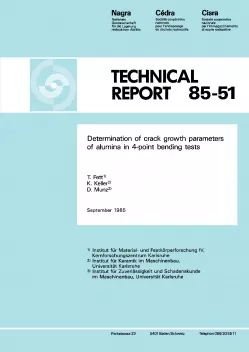
Technical Report NTB 85-51
Determination of crack growth parameters of alumina in 4-point bending tests
Alumina containers are being considered for the disposal of nuclear waste in a number of countries. For this ceramic material subcritical crack growth is a potentially important failure mechanism.
The crack growth behaviour of one particular type of hot isostatically pressed alumina has been investigated at 70°C in a strongly corrosive brine using fracture-mechanical methods. The use of a recently developed method for interpreting lifetime measurements in static bending tests allowed a determination of crack growth rates as low as 10-11 m/s.
It was observed that the dependence of the crack growth rate on the stress intensity factor can be described in terms of a power law over the whole range investigated. The exponent in the power law was found to be close to n = 20. Published values for the same material, determined by the double torsion method, lie above n = 100. The discrepancy between these values is probably due to R-curve effects (i.e. to an increase of the critical stress intensity factor in the course of crack extension) that influence the behaviour of macroscopic cracks and that of natural cracks about 100 μm in size differently.
Because of the high lifetime required of containers for final disposal of radioactive waste the low values determined for the crack growth exponent imply that tensile stresses must be kept quite small.
